 Pocket Tunes has long been the most popular audio player on the Palm OS, and the recent update to version 4 has produced a raft of cool new features including an Internet Radio Catalogue, a swanky new interface and album cover art support.
Pocket Tunes has long been the most popular audio player on the Palm OS, and the recent update to version 4 has produced a raft of cool new features including an Internet Radio Catalogue, a swanky new interface and album cover art support.
Loading up the application, the sleek dark blue graphics immediately impressed, offering a smooth, shiny, Vista-like interface.
Album art could now be seen on the main screen and clicking on the small image (or pressing ‘w’ on the keyboard) brought up a full screen version, albeit a tad pixelated.
Running along the top of the screen are current time and battery info, plus with access to the drop down prefs and options menus (more about them later).
Underneath is the song information area, displaying the track’s artwork, title, artist and album name.
A large, animated, two-tone horizontal bar keeps the user informed of the played/total time of the current track, with the option to tap or drag forwards or backwards through a song.
A window below displays five songs from the current playlist (six if you reduce the default font from small to positively teensy weensy), while bashing ‘L’ on the keyboard gives speedy access to the playlist manager.
Sitting below the track listing are tappable controls for shuffle & repeat and a draggable volume display bar with percentage readout.
Finally, a large row of five buttons at the bottom of the interface lets you rewind, play/pause and fast forward through your selections, either by clicking onscreen or by using the Palm’s hardware buttons.
 Streaming Internet Radio
Streaming Internet Radio
The final button is perhaps the most interesting, launching the Internet Radio manager, which offers a pre-installed catalogue of Shoutcast stations (previous versions required users to input station URLs in manually).
There’s a fairly comprehensive list available, although it has something of an American bias and, sadly, nothing from the good ol’BBC (the Beeb doesn’t provide the necessary aacPlus or MP3 streams).
Tuning into a station is a bit of revelation; even though we were connecting via a bog standard GPRS connection, the sound quality was generally excellent, with no stuttering.
We weren’t able to connect to all of the stations on the list however, but it was fun tuning into a Hawaiian radio station while looking out into the London gloom.
Of course, you’re going to need a very generous GPRS data allowance if you intend to use the radio frequently, so check with your network provider before settling into that four hour Icelandic folk remix.
 As with MP3s we had no problems listening to radio streams in the background while we used the Treo for sending off emails and editing a Word document, although the phone was occasionally a tad sluggish when switching between apps.
As with MP3s we had no problems listening to radio streams in the background while we used the Treo for sending off emails and editing a Word document, although the phone was occasionally a tad sluggish when switching between apps.
The application handled phone calls well too – if we received a call, the stream would pause and then reconnect after the call had ended.
Mini console
Another nice feature is the mini MP3 player that can be called up when you’re using other applications and playing songs in the background.
This pops up on the lower half of the screen and gives quick access to song controls, so you can skip songs without having to open up the full program.
Formats
The player can handle all the major file formats like MP3, WMA, AAC, aacPlus, Ogg Vorbis, and WAV, with the deluxe version supporting PlaysForSure and DRM-protected content (but not iTunes files).
When hooked up to a PC, Pocket Tunes appears as a regular MTP (Media Transfer Protocol) media player and can then sync music, playlists and podcasts with any compatible desktop software.
Although we had no problem syncing over files, we preferred to make the job quicker by slamming the SD card into a media reader and transferring the files over that way.
 Once the music is loaded up on your Palm, the program shuffles through the list and categorises the content into Artist, Album, Title and Genre sub-categories.
Once the music is loaded up on your Palm, the program shuffles through the list and categorises the content into Artist, Album, Title and Genre sub-categories.
Sound quality
Although the makers Normsoft are making a bit of a hoo-ha about the improved audio quality in the new version, we were hard pressed to notice any big difference.
Maybe if we got out our Grado S60s it would become apparent, but seeing as Version 3 sounded good and, err, Version 4 sounds good too, we’re not complaining.
The 5-band graphic equaliser definitely seemed an improvement on the previous version though, as that seemed apt to distort when you tried to introduce Phil Spector-esque soundscapes. For some, the simple Bass Boost button might be enough.
There’s also support for cross-fading across variable bitrate tracks, if that’s your bag, with optional plug-ins adding expansion possibilities.
Options
As with previous versions, Pocket Tunes comes with a wealth of options to customise the program to your tastes. The program comes with a skinnable interface, with lots of mighty purdy free skins available from third party sites as well as Normsoft’s own site.
The skins can be moved to the memory card too, which is a good thing as the lardy 1.8 meg Pocket Tunes application will take a fair chunk of your Palm’s memory.
For those in a tight squeeze, it is possible to run the program off the SD card, albeit with some caveats, as Normsoft explained to us:
 “We still do not recommend running Pocket Tunes from a SD card because you cannot launch a stream from Blazer (system limitation), however this is less problematic in 4.0 because it has a built-in Internet radio catalog, no longer requiring the user to use Blazer.
“We still do not recommend running Pocket Tunes from a SD card because you cannot launch a stream from Blazer (system limitation), however this is less problematic in 4.0 because it has a built-in Internet radio catalog, no longer requiring the user to use Blazer.
There is still an issue with Pocket Tunes sometimes being left in internal memory when running from a SD card. Some customers have found that PowerRun helps to prevent this from occurring.”
Conclusion
Sporting a smart and modern interface and a wealth of new features, this latest version of Pocket Tunes truly is a must-have application for music fans using the Palm OS.
We loved the new features – especially the Internet radio – and can thoroughly recommend the program, despite its upmarket pricing; $37.95 for the Deluxe version and $19.95 for the Basic (sans support for DRM-protected music, Internet Radio, AAC, WMA, crossfading and bookmarks.)
Features: 91%
Ease of use: 85%
Value For Money: 75%
Overall: 90%
Pocket Tunes
Technical Specifications
Audio Support: MP3 (all bitrates, CBR and VBR), AAC (all bitrates), WMA, Protected WMA (PD-DRM WMDRM9, Janus WMDRM10), aacPlus/HE-AAC v1, aacPlus/HE-AAC v2, Ogg Vorbis, PCM WAV.
Playlist Support: Stored on SD card: M3U, PLS. Stored on device: internal playlist format. Accessed via HTTP: M3U, PLS. Other capabilities: playlists that include other playlists are expanded automatically.
Streaming Audio: Protocols: HTTP, ShoutCast, Live365. Formats: MP3, aacPlus, Ogg Vorbis, WAV.
Album art: JPEG format any size (depending on available memory).
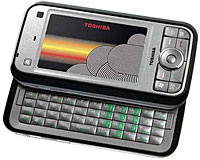 A cavalcade of new phones are continuing to spew forth from the 3GSM World Congress bash in Barcelona, and one that has especially warmed our toilet seats of desire is the ‘G900’ smartphone from Toshiba.
A cavalcade of new phones are continuing to spew forth from the 3GSM World Congress bash in Barcelona, and one that has especially warmed our toilet seats of desire is the ‘G900’ smartphone from Toshiba.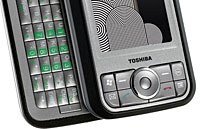 To ensure that the vast display is topped up with fast and fresh web pages there’s ultra-nippy HSDPA connectivity onboard (take that, iPhone!), with 64MB of internal memory and a miniSD card taking care of storage duties.
To ensure that the vast display is topped up with fast and fresh web pages there’s ultra-nippy HSDPA connectivity onboard (take that, iPhone!), with 64MB of internal memory and a miniSD card taking care of storage duties.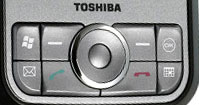 Extra security comes in the form of a rear biometric scanner, and there’s also Bluetooth with A2DP support, Wi-Fi, USB On-The-Go and Microsoft’s new Windows Mobile 6 OS.
Extra security comes in the form of a rear biometric scanner, and there’s also Bluetooth with A2DP support, Wi-Fi, USB On-The-Go and Microsoft’s new Windows Mobile 6 OS.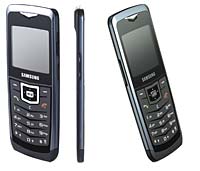 There may be controversy on the catwalks, but thin remains in with the design bods at Samsung, who have just unleashed a trio of anorexic handsets in their Ultra range, the U300, U600, U700 and ultra-thin U100.
There may be controversy on the catwalks, but thin remains in with the design bods at Samsung, who have just unleashed a trio of anorexic handsets in their Ultra range, the U300, U600, U700 and ultra-thin U100.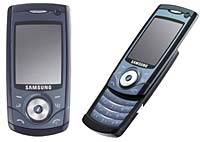 Back to the real world, there’s no denying that the U100 is an impressive piece of engineering – and purdy as a picture too – packing in a 3 mega-pixel camera, a 1.93″ color TFT screen and 11 hours of music play time into its 5.9mm wide frame.
Back to the real world, there’s no denying that the U100 is an impressive piece of engineering – and purdy as a picture too – packing in a 3 mega-pixel camera, a 1.93″ color TFT screen and 11 hours of music play time into its 5.9mm wide frame.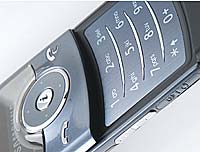 Adjusting the BS output to ‘stun,’ the press announcement tells us that the handset apparently exudes “elegance and modern style… for the ultimate sophistication” and comes in a suitably daftly-named set of colours, including sapphire blue, garnet red, platinum metal and copper gold casing.
Adjusting the BS output to ‘stun,’ the press announcement tells us that the handset apparently exudes “elegance and modern style… for the ultimate sophistication” and comes in a suitably daftly-named set of colours, including sapphire blue, garnet red, platinum metal and copper gold casing.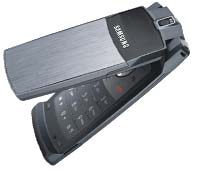 Wrapping up the new line-up is the U300, a 9.6-mm clamshell with a 3-megapixel camera, Bluetooth, TV-out capability and 70MB of onboard storage (but no MicroSD slot).
Wrapping up the new line-up is the U300, a 9.6-mm clamshell with a 3-megapixel camera, Bluetooth, TV-out capability and 70MB of onboard storage (but no MicroSD slot).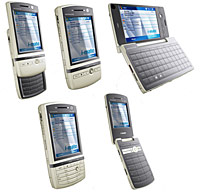 In an advanced Hedge-Betting exercise, i-mate has announced its new range of Windows Mobile devices, with a set of designs mirroring just about every handset currently available on the market.
In an advanced Hedge-Betting exercise, i-mate has announced its new range of Windows Mobile devices, with a set of designs mirroring just about every handset currently available on the market.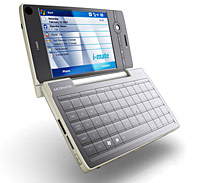 Christened the “Ultimate” range, the WM6-powered devices – all five of ’em – are numbered 5150, 6150, 7150, 9150, and 8150 (clockwise from the upper left in the compilation photo) – if you’re bored, you can play “spot the inspiration” and see if you match i-mate’s new offerings to current designs by other manufacturers.
Christened the “Ultimate” range, the WM6-powered devices – all five of ’em – are numbered 5150, 6150, 7150, 9150, and 8150 (clockwise from the upper left in the compilation photo) – if you’re bored, you can play “spot the inspiration” and see if you match i-mate’s new offerings to current designs by other manufacturers.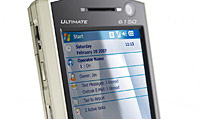 Full details of the whole range are still dribbling through, but we’ve learnt that the Ultimate 5150 slider comes with an Intel Bulverde 520MHz CPU, VGA screen, 256MB ROM and 128MB RAM, Wi-Fi, microSD memory card slot and a 2.0 megapixel camera.
Full details of the whole range are still dribbling through, but we’ve learnt that the Ultimate 5150 slider comes with an Intel Bulverde 520MHz CPU, VGA screen, 256MB ROM and 128MB RAM, Wi-Fi, microSD memory card slot and a 2.0 megapixel camera.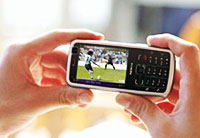 Nordic big-knobs Nokia have knocked out another two handsets for your delectation today.
Nordic big-knobs Nokia have knocked out another two handsets for your delectation today.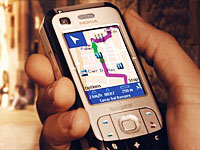 Lurking on the back is a 2 megapixel camera, with the N77 delivering on the multimedia front, offering visual radio and support for MP3, AAC, AAC+, eAAC+ and WMA media.
Lurking on the back is a 2 megapixel camera, with the N77 delivering on the multimedia front, offering visual radio and support for MP3, AAC, AAC+, eAAC+ and WMA media.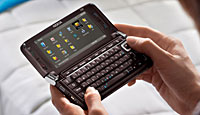 Nokia E90 Communicator
Nokia E90 Communicator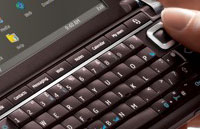 There’s also integrated GPS and Nokia Maps wedged into the chunky handset, but all those features are going to come at a wallet-whipping price, with the E90 expected to be priced at around a stratospheric €750.
There’s also integrated GPS and Nokia Maps wedged into the chunky handset, but all those features are going to come at a wallet-whipping price, with the E90 expected to be priced at around a stratospheric €750.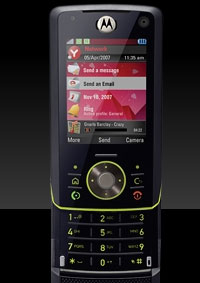 We reckon there could be moist spots breaking out in the gussets of mobile phone freaks everywhere with a veritable onslaught of new phones being announced today.
We reckon there could be moist spots breaking out in the gussets of mobile phone freaks everywhere with a veritable onslaught of new phones being announced today.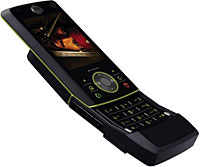 Decked out in a natty black body with green trim, the MOTORIZR Z8 features a 1.4 x 2-inch, QVGA 16 million colour display and a twin camera set up, with a 2 megapixel camera on the back (with 8x zoom and lumi LED light) and a lower spec’d VGA jobbie up front for video calls.
Decked out in a natty black body with green trim, the MOTORIZR Z8 features a 1.4 x 2-inch, QVGA 16 million colour display and a twin camera set up, with a 2 megapixel camera on the back (with 8x zoom and lumi LED light) and a lower spec’d VGA jobbie up front for video calls.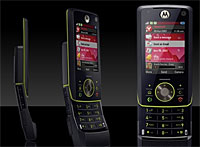 There’s also A2DP stereo Bluetooth audio onboard, support for SMS, EMS, MMS 1.22 messaging and SMTP, POP3, IMAP4, SSL/TLS2 email.
There’s also A2DP stereo Bluetooth audio onboard, support for SMS, EMS, MMS 1.22 messaging and SMTP, POP3, IMAP4, SSL/TLS2 email. Nokia, the undisputed heavyweight champs of the mobile phone world, have taken the wraps off their new 6110 Navigator smartphone.
Nokia, the undisputed heavyweight champs of the mobile phone world, have taken the wraps off their new 6110 Navigator smartphone. According to Nokia, they will be offering the smart2go on Nokia S60 and Windows Mobile 5.0 devices, and then rolling out support for most of the major mobile OS platforms including Nokia S60/S40, PocketPC, Linux and other Windows Mobile devices.
According to Nokia, they will be offering the smart2go on Nokia S60 and Windows Mobile 5.0 devices, and then rolling out support for most of the major mobile OS platforms including Nokia S60/S40, PocketPC, Linux and other Windows Mobile devices.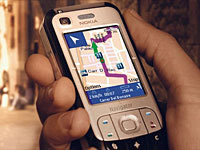 UPDATE: Image through now …. der dah!
UPDATE: Image through now …. der dah!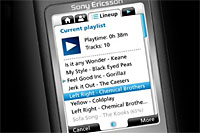 You may not have heard of them yet, but feisty Brit mobile music company Omnifone have announced one of the first big challengers to Apple’s soon-come iPhone/iTunes Store service.
You may not have heard of them yet, but feisty Brit mobile music company Omnifone have announced one of the first big challengers to Apple’s soon-come iPhone/iTunes Store service.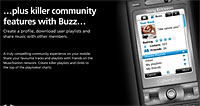 “We will ensure the vast majority of Europeans have the freedom to choose MusicStation by the time iPhone arrives in Europe. We will give consumers the choice they deserve,” he added.
“We will ensure the vast majority of Europeans have the freedom to choose MusicStation by the time iPhone arrives in Europe. We will give consumers the choice they deserve,” he added. Predictably, music tracks will come with digital rights management and be delivered in the eAAC+ format (that’s enhanced advanced audio coding, in case you’re into knowing that kind of thing).
Predictably, music tracks will come with digital rights management and be delivered in the eAAC+ format (that’s enhanced advanced audio coding, in case you’re into knowing that kind of thing).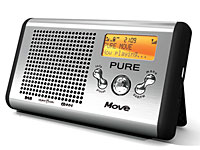 Designers of DAB radios seem a strange lot.
Designers of DAB radios seem a strange lot.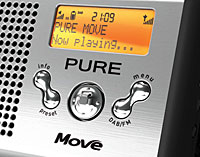 Sensing a gap in the market, leading UK DAB manufacturer Pure have come up with the Pure Move.
Sensing a gap in the market, leading UK DAB manufacturer Pure have come up with the Pure Move.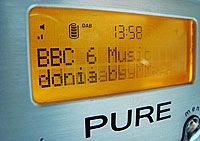 Obviously, bass heads aren’t going to get their denture rattling fix from something as diminutive as this fella, but the sound quality was punchy and pleasing enough for everyday use.
Obviously, bass heads aren’t going to get their denture rattling fix from something as diminutive as this fella, but the sound quality was punchy and pleasing enough for everyday use.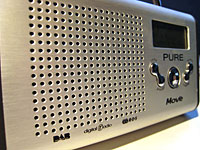 Conclusion
Conclusion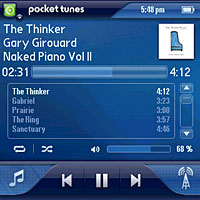 Pocket Tunes has long been the most popular audio player on the Palm OS, and the recent update to version 4 has produced a raft of cool new features including an Internet Radio Catalogue, a swanky new interface and album cover art support.
Pocket Tunes has long been the most popular audio player on the Palm OS, and the recent update to version 4 has produced a raft of cool new features including an Internet Radio Catalogue, a swanky new interface and album cover art support.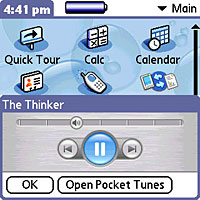 Streaming Internet Radio
Streaming Internet Radio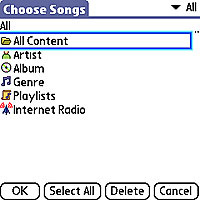 As with MP3s we had no problems listening to radio streams in the background while we used the Treo for sending off emails and editing a Word document, although the phone was occasionally a tad sluggish when switching between apps.
As with MP3s we had no problems listening to radio streams in the background while we used the Treo for sending off emails and editing a Word document, although the phone was occasionally a tad sluggish when switching between apps.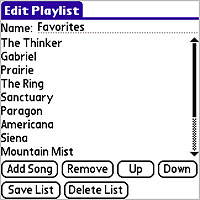 Once the music is loaded up on your Palm, the program shuffles through the list and categorises the content into Artist, Album, Title and Genre sub-categories.
Once the music is loaded up on your Palm, the program shuffles through the list and categorises the content into Artist, Album, Title and Genre sub-categories.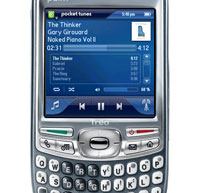 “We still do not recommend running Pocket Tunes from a SD card because you cannot launch a stream from Blazer (system limitation), however this is less problematic in 4.0 because it has a built-in Internet radio catalog, no longer requiring the user to use Blazer.
“We still do not recommend running Pocket Tunes from a SD card because you cannot launch a stream from Blazer (system limitation), however this is less problematic in 4.0 because it has a built-in Internet radio catalog, no longer requiring the user to use Blazer.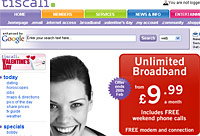 Tiscali has unveiled plans to launch a television service for its broadband subscribers, offering more than 30 digital channels and on-demand programming.
Tiscali has unveiled plans to launch a television service for its broadband subscribers, offering more than 30 digital channels and on-demand programming. Commenting on their new offering, Mary Turner, chief executive Tiscali UK said, “The success of Freeview has shown that customers want more than five channels but don’t necessarily want to pay a high monthly subscription.”
Commenting on their new offering, Mary Turner, chief executive Tiscali UK said, “The success of Freeview has shown that customers want more than five channels but don’t necessarily want to pay a high monthly subscription.”